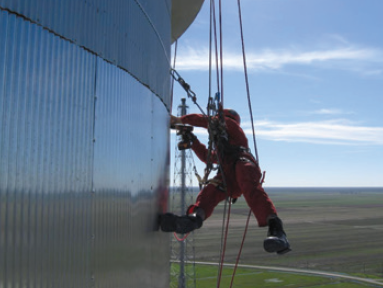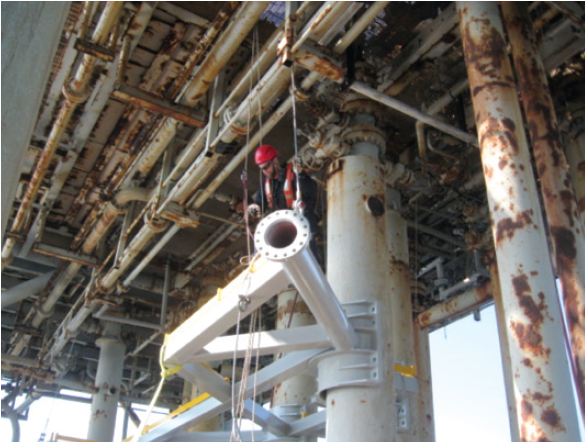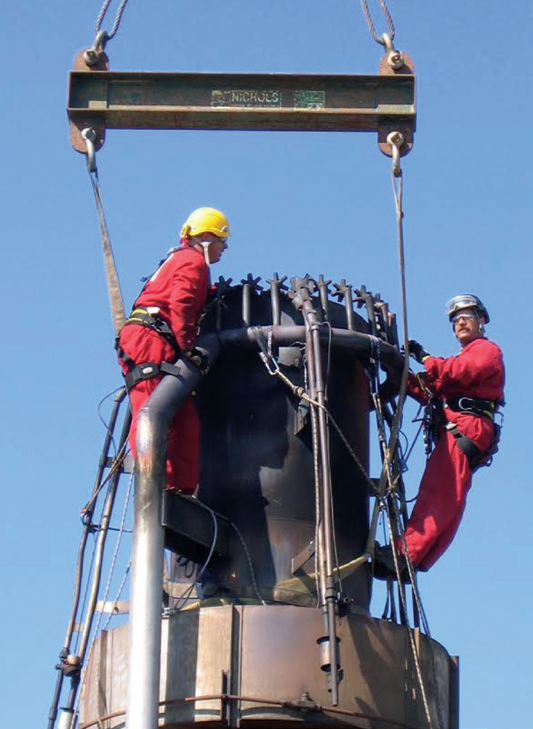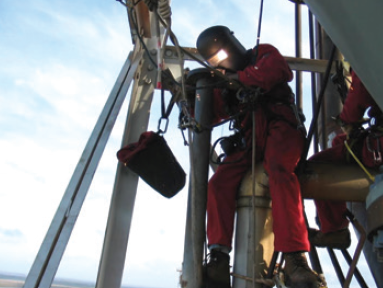Introduction
Industrial rope access, as the name implies, is an access method that features the use of ropes and climbing techniques to reach difficult areas. Rope access allows for a wide variety of work to be performed at high elevations or other hard to reach areas without the use of scaffolding or heavy equipment. It has evolved from techniques used in rock climbing and caving to become an extremely safe and cost effective industrial tool. The rope access industry has compiled an exemplary safety record over the past thirty years while logging millions of man-hours. Most recently, rope access has gained regulatory acceptance and is being written into the ANSI Z359 Standards.

Rope Acess for Inspection
Rope access techniques have minimized the amount of man power and the need for equipment on various projects while also maintaining a high degree of safety. This fact greatly reduces the overall risk exposure at the job site and makes it a safer alternative to conventional access methods. Much of the growth in the rope access industry can be attributed to the reduction or elimination of scaffolding on projects, but it is rather short sited to just look at the savings in scaffold costs as the only true value of rope access services. When used properly, the value is much greater and shows up in a multitude of ways.
Rope access is commonly used to carry out the inspection of piping, columns, vessels, supports, and other structures. Inspections using various nondestructive testing (NDT) methods are commonly performed by rope access technicians and the work can be completed in a safe and timely manner. A rope access team also has the ability to combine multiple crafts to increase the efficiency of the work being performed. This could be as simple as performing insulation work in addition to an ultrasonic thickness inspection. In such a situation, the rope access crew can cut inspection windows, perform the necessary inspection, and close the inspection windows all at the same time. This type of efficiency could allow for a unit inspector to manage one crew to complete the needed work scope instead of having to coordinate a scaffolding crew, insulation crew, and inspection crew; which will allow for time to be spent on other responsibilities.
Rope access can also allow for a greater degree of inspection to be performed. With the additional accessibility that can be provided, inspections are no longer limited to accessible areas near ladders and platforms, nor are they limited by the costs associated with erecting a scaffold. Any part of a vessel or piping system is now available for inspection. Additionally, while rope access crews are working at height, areas that are not typically within view can be seen on the equipment that is part of the work scope and the crew could also spot irregularities that exist on other equipment in close proximity. Often, these places are hard to reach even during turnarounds and outages so they are typically not maintained as well as the easily visible areas of the unit.
The cost savings are rather obvious when the work scope requires UT readings on an overhead line that is 200 feet above grade, but rope access crews are also efficient working close to the ground. In a recent large scale Retro PMI project, by using rope access teams to complete the work the customer realized a reduction in the cost per point of roughly 65% in comparison to past corporate practices.
Coupling with Advanced NDE
Inspection becomes even more powerful when advanced NDT services are added to the mix. Performing an AUT scan on the back side of a vessel or on remote piping can gather a tremendous amount of information. Phased array UT on an elevated weld seam, guided wave UT to find welds and corrosion on long runs of pipe, eddy current scanning for surface cracking and tube inspections; all of these technologies have been proven on their own merit, and rope access can make them more available and effective.


Rope Access for Maintenance
Rope access is by no means limited to inspection. Mechanical work, welding, insulation, painting, electrical, and, cleaning, can all be completed utilizing this technique. Using rope access, crews have hung piping, installed spring hangers, insulated piping and vessels, replaced siding, cleaned and coated, de-slagged, and performed a host of other tasks. Again, one can point to the reduction in scaffolding costs, but often the time savings is more valuable. On a large coker unit, rope access was brought in to perform the interior portion of a drum crack repair. The unit downtime was reduced from an average of 8 days to only 4 days.
Since work can be completed quickly, plants can take advantage of short time windows to complete projects. With enough rope access technicians to work day and night, 400 feet of vertical steam piping was replaced during a 4 day outage on a flare. The ability to get into position quickly can be even more valuable during unplanned outages where information is needed to make decisions.
Rope access can also be used in conjunction with conventional methods and equipment. Rope access technicians tend to be good riggers which makes them helpful on heavy lifts such as flare tip changes with a crane. They can also make use of air tuggers. With the ability to set pulleys and re-direct quickly, very heavy equipment can be moved easily. Rope access technicians can also be used to set staging for non-climbing workers. Rope access was involved on an offshore deck replacement project. The project was completed in roughly 30% less time than similar projects and with a large reduction in overall man hours.

Preventative maintenance can be carried out to a higher level using rope access. Generally a maintenance manager is not going to build a large scaffold to fix loose jacketing or slipped bands. But in time these can grow into major problems, especially since all facilities are subject to storms from time to time. Rope access makes these types of repairs affordable. Screwing down loose panels, securing slipped bands, cleaning and coating rust spots, as well as other tasks can greatly lengthen the service duration of equipment.
Limitations
Naturally, this technique does have its limitations and not every job is a best suited for rope access application. For one, rope access technicians are highly trained so their billing rates are typically 20%-30% higher than the comparable craft on the ground. Projects where a very large number of workers are needed may shift the economics away from rope access. Another potential limitation exists around hot equipment. While work can be completed on the equipment itself, if the area is too hot, such as above heat exchanger fans, it might be too dangerous for rope access technicians to work there.
Conclusion
In conclusion, rope access is a valuable tool that can enable operators to improve their inspection and maintenance efforts. It can prove valuable in many applications and, when used properly, rope access can save time, money, and make facilities safer.

















Comments and Discussion
There are no comments yet.
Add a Comment
Please log in or register to participate in comments and discussions.